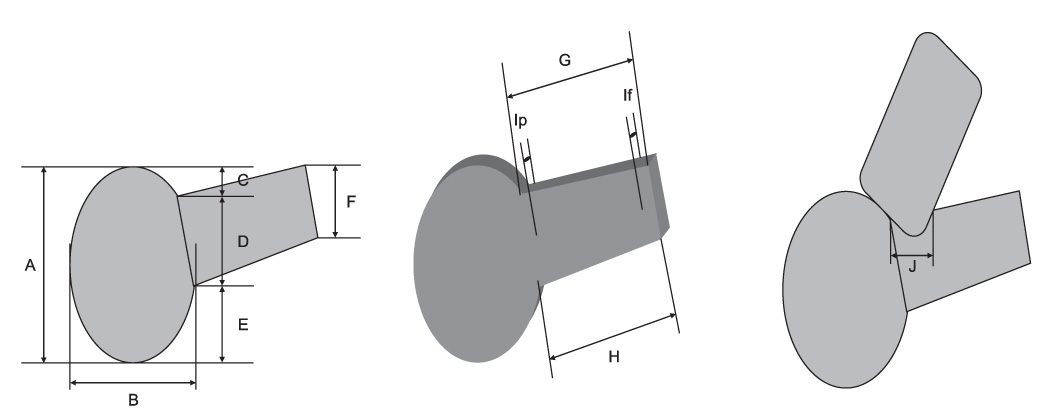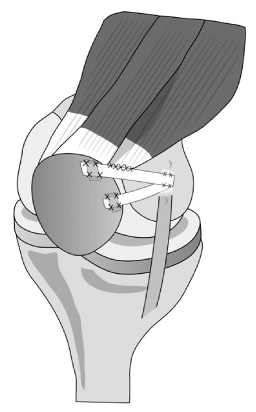J Korean Orthop Assoc.
2011 Dec;46(6):443-450.
Anatomical Reconstruction of the Medial Patellofemoral Ligament: Development of a Novel Procedure Based on Anatomical Dissection
- Affiliations
-
- 1Department of Orthopedic Surgery, Hanmi Hospital, Daegu, Korea.
- 2Department of Orthopedic Surgery, Sanggye Paik Hospital, Inje University College of Medicine, Seoul, Korea.
- 3Department of Orthopedic Surgery, Seoul Paik Hospital, Inje University College of Medicine, Seoul, Korea. boram107@hanmail.net
- 4Department of Orthopedic Surgery, Gachon University Gil Hospital, Incheon, Korea.
- 5Department of Orthopedic Surgery, Seoul Sky Hospital, Seoul, Korea.
Abstract
- This paper reports a novel method for reconstructing the medial patellofemoral ligament (MPFL) using hamstring tendon autografts, based on the results of an anatomical study by cadaveric dissection. Five fresh frozen cadaveric knees were studied. MPFL was found present in all cases, and the average length was 54 mm (49.6-59.3 mm). The shape of the MPFL was triangular wherein the femoral attachment was narrow and the patellar attachment was relatively broad. The MPFL was less stiff and a weaker structure compared to the other ligaments. This study could refl ect a novel surgical technique for the MPFL reconstruction with its anatomical and biomechanical properties. The study population comprises of 9 patients (5 males and 4 females) who underwent primary MPFL reconstruction at our clinic between April 2008 and February 2010. The mean follow-up period was 17.6 months. The Kujala score improved signifi cantly from 51.1 points to 81.4 points (p<0.001), the Lysholm score improved signifi cantly from 47.8 points to 84.9 points (p<0.001) and the Tegner activity level improved signifi cantly from 2.9 to 5.1 (p<0.001). There was no case of recurrent dislocation and complications according to the short term follow-up results. Our novel soft tissue fixation method using double bundle reconstruction with hamstring tendon autografts would not only be an anatomic reconstruction but also would be effective for reconstruction of the MPFL.
MeSH Terms
Figure
Reference
-
1. Dandy DJ, Griffiths D. Lateral release for recurrent dislocation of the patella. J Bone Joint Surg Br. 1989. 71:121–125.
Article2. Garth WP Jr, DiChristina DG, Holt G. Delayed proximal repair and distal realignment after patellar dislocation. Clin Orthop Relat Res. 2000. (377):132–144.
Article3. Myers P, Williams A, Dodds R, Bülow J. The three-in-one proximal and distal soft tissue patellar realignment procedure. Results, and its place in the management of patellofemoral instability. Am J Sports Med. 1999. 27:575–579.4. Post WR, Fulkerson JP. Distal realignment of the patellofemoral joint. Indications, effects, results, and recommendations. Orthop Clin North Am. 1992. 23:631–643.5. Scuderi G, Cuomo F, Scott WN. Lateral release and proximal realignment for patellar subluxation and dislocation. A long-term follow-up. J Bone Joint Surg Am. 1988. 70:856–861.
Article6. Small NC, Glogau AI, Berezin MA. Arthroscopically assisted proximal extensor mechanism realignment of the knee. Arthroscopy. 1993. 9:63–67.
Article7. Desio SM, Burks RT, Bachus KN. Soft tissue restraints to lateral patellar translation in the human knee. Am J Sports Med. 1998. 26:59–65.
Article8. Hautamaa PV, Fithian DC, Kaufman KR, Daniel DM, Pohlmeyer AM. Medial soft tissue restraints in lateral patellar instability and repair. Clin Orthop Relat Res. 1998. (349):174–182.
Article9. Panagiotopoulos E, Strzelczyk P, Herrmann M, Scuderi G. Cadaveric study on static medial patellar stabilizers: the dynamizing role of the vastus medialis obliquus on medial patellofemoral ligament. Knee Surg Sports Traumatol Arthrosc. 2006. 14:7–12.
Article10. Tuxøe JI, Teir M, Winge S, Nielsen PL. The medial patellofemoral ligament: a dissection study. Knee Surg Sports Traumatol Arthrosc. 2002. 10:138–140.
Article11. Muneta T, Sekiya I, Tsuchiya M, Shinomiya K. A technique for reconstruction of the medial patellofemoral ligament. Clin Orthop Relat Res. 1999. (359):151–155.12. Nomura E, Inoue M. Surgical technique and rationale for medial patellofemoral ligament reconstruction for recurrent patellar dislocation. Arthroscopy. 2003. 19:E47.
Article13. Noyes FR, Albright JC. Reconstruction of the medial patellofemoral ligament with autologous quadriceps tendon. Arthroscopy. 2006. 22:904.e1–904.e7.
Article14. Schöttle P, Schmeling A, Romero J, Weiler A. Anatomical reconstruction of the medial patellofemoral ligament using a free gracilis autograft. Arch Orthop Trauma Surg. 2009. 129:305–309.
Article15. Steensen RN, Dopirak RM, Maurus PB. A simple technique for reconstruction of the medial patellofemoral ligament using a quadriceps tendon graft. Arthroscopy. 2005. 21:365–370.
Article16. Sillanpää P, Mattila VM, Visuri T, Mäenpää H, Pihlajamäki H. Ligament reconstruction versus distal realignment for patellar dislocation. Clin Orthop Relat Res. 2008. 466:1475–1484.
Article17. Amis AA, Firer P, Mountney J, Senavongse W, Thomas NP. Anatomy and biomechanics of the medial patellofemoral ligament. Knee. 2003. 10:215–220.
Article18. Feller JA, Feagin JA Jr, Garrett WE Jr. The medial patellofemoral ligament revisited: an anatomical study. Knee Surg Sports Traumatol Arthrosc. 1993. 1:184–186.
Article19. Smirk C, Morris H. The anatomy and reconstruction of the medial patellofemoral ligament. Knee. 2003. 10:221–227.
Article20. Arendt EA, Fithian DC, Cohen E. Current concepts of lateral patella dislocation. Clin Sports Med. 2002. 21:499–519.
Article21. Elias JJ, Cosgarea AJ. Technical errors during medial patellofemoral ligament reconstruction could overload medial patellofemoral cartilage: a computational analysis. Am J Sports Med. 2006. 34:1478–1485.22. Ahmad CS, Brown GD, Stein BS. The docking technique for medial patellofemoral ligament reconstruction: surgical technique and clinical outcome. Am J Sports Med. 2009. 37:2021–2027.23. Sillanpää PJ, Mäenpää HM, Mattila VM, Visuri T, Pihlajamäki H. A mini-invasive adductor magnus tendon transfer technique for medial patellofemoral ligament reconstruction: a technical note. Knee Surg Sports Traumatol Arthrosc. 2009. 17:508–512.
Article24. Schöttle PB, Hensler D, Imhoff AB. Anatomical double-bundle MPFL reconstruction with an aperture fi xation. Knee Surg Sports Traumatol Arthrosc. 2010. 18:147–151.25. Zhang L, Li Z, Liu J, Sun J, Ma J. Anatomical double bundle reconstruction of medial patellofemoral ligament with allograft tendon in patellar dislocations. Zhongguo Xiu Fu Chong Jian Wai Ke Za Zhi. 2010. 24:100–103.26. LaPrade RF, Engebretsen AH, Ly TV, Johansen S, Wentorf FA, Engebretsen L. The anatomy of the medial part of the knee. J Bone Joint Surg Am. 2007. 89:2000–2010.
Article27. Bicos J, Fulkerson JP, Amis A. Current concepts review: the medial patellofemoral ligament. Am J Sports Med. 2007. 35:484–492.28. Zavras TD, Race A, Bull AM, Amis AA. A comparative study of 'isometric' points for anterior cruciate ligament graft attachment. Knee Surg Sports Traumatol Arthrosc. 2001. 9:28–33.
Article29. Harner CD, Janaushek MA, Kanamori A, Yagi M, Vogrin TM, Woo SL. Biomechanical analysis of a double-bundle posterior cruciate ligament reconstruction. Am J Sports Med. 2000. 28:144–151.
Article30. Race A, Amis AA. PCL reconstruction. In vitro biomechanical comparison of 'isometric' versus single and double-bundled 'anatomic' grafts. J Bone Joint Surg Br. 1998. 80:173–179.31. Parker DA, Alexander JW, Conditt MA, Uzodinma ON, Bryan WJ. Comparison of isometric and anatomic reconstruction of the medial patellofemoral ligament: a cadaveric study. Orthopedics. 2008. 31:339–343.
Article32. Wang F, Chen BC, Kang HJ, Wang J, Liu H, Dong JT. Comparison of clinical results between an isometric and an anatomic technique for medial patellofemoral ligament reconstruction. Zhonghua Wai Ke Za Zhi. 2010. 48:891–895.
- Full Text Links
- Actions
-
Cited
- CITED
-
- Close
- Share
- Similar articles
-
- Medial Patellofemoral Ligament Reconstruction: A Comprehensive Review
- Tunnel Position for Anatomical Reconstruction of the Anterior Cruciate Ligament
- Surgical Reconstruction of the Torn Medial Collateral Ligament of the Knee: Clinical Study
- Medial Patellofemoral Ligament Reconstruction Using Adjustable Tensioning under Arthroscopic Visualization Provides Satisfactory Radiographic and Clinical Outcomes
- Anatomical Reconstruction of the Medial Orbital Wall Fracture






